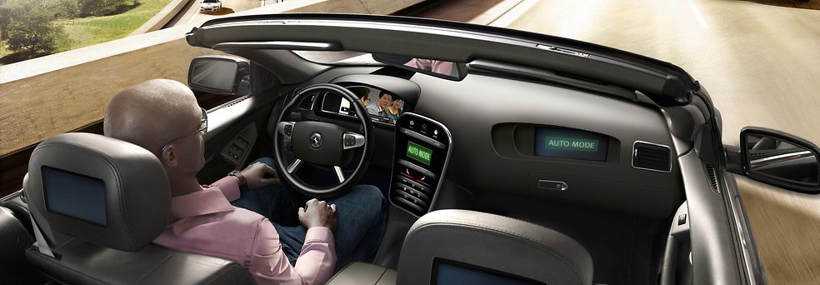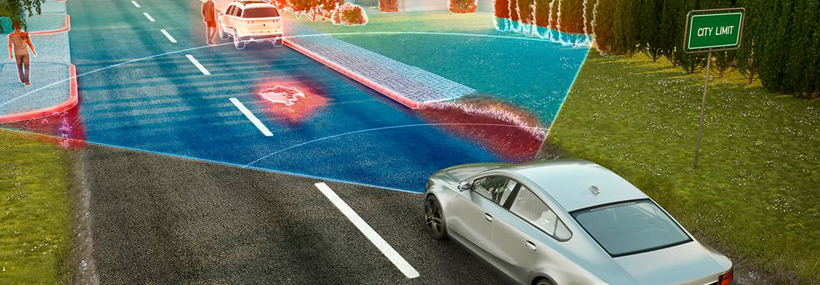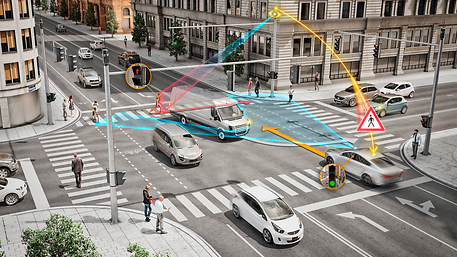In the wave of great changes in autonomous driving, everyone has a dream of autonomous driving in their hearts, and Continental is no exception.
Based on three key application scenarios
In Continental's autonomous driving map, autonomous highway cruising, automatic valet parking and CUbE driverless cars complement each other and together constitute Continental's "seamless driving" solution for future automated driving.
● Autonomous cruising on highways
Compared with crowded urban roads, highways are considered to be one of the scenarios where autonomous driving can be realized first because of their relatively closed scenes, fixed routes, and fewer variables that need to be considered in vehicle operation.
Continental's highway autonomous cruise function can independently complete driving requirements on the highway, including automatic lateral and longitudinal control, automatic lane keeping in curves, lane switching according to the driver's needs, etc., and automatically adjust the speed according to traffic conditions and traffic rules, thereby temporarily liberating the driver from the slightly boring highway driving scene and allowing them to take a break. After exiting the highway, the system will inform the driver in advance and return the driving rights. Of course, if the driver finds that the vehicle is out of control during the journey, he can also take over the vehicle at any time to ensure driving safety.
In August this year, Continental demonstrated its autonomous highway cruising function through a demonstration car equipped with a long-range radar, four short-range radars and an in-car stereo camera.
● Automatic valet parking
According to Continental's vision, after the self-driving car arrives at the valet parking lot in autonomous cruising mode, the automatic valet parking function can allow the vehicle to search for parking spaces in the parking lot by itself using the integrated sensor system. When the car arrives at the parking lot, the driver gets out of the car and starts the parking system on the mobile phone. The car will search for parking spaces in the parking lot and park automatically. When the driver finishes his business and returns to the pick-up point, he can call back the car and get in through the mobile phone program.
In August this year, Elektrobit, a wholly-owned subsidiary of Continental AG, established a strategic partnership with Baidu. According to the cooperation agreement, EB will provide its EB tresos automotive basic software products to Baidu's AVP dedicated mass production computing unit ACU, helping manufacturers using Baidu ACU to accelerate the commercialization of AVP.

Image source: Continental AG official website
● CUbE driverless car
If it is in a large commercial street or park, after parking the car, the driver often needs to walk a distance to reach the final destination. This is when Continental's CUbE driverless car comes in handy.
CUbE is Continental's development platform for driverless technology. The platform is built on the EasyMile driverless bus EZ10 platform and integrates all Continental's perception, planning, and action-related products. It can drive safely and autonomously in a designated area. CUbE is equipped with lidar, cameras, and radar sensors, which can achieve precise positioning, while also promptly identifying obstacles and potential road hazards. By integrating safe V2X communication technology, CUbE enables communication and data exchange with other road users and infrastructure. The auxiliary and autonomous driving control unit ADCU analyzes the data generated by the sensors and effectively plans actions. In this way, the driverless CUbE can take timely actions based on real-time road conditions.
It is worth noting that Continental’s purpose in building this platform is not to develop CUbE into a production-ready vehicle, but to allow Continental’s series of technologies, such as braking systems and environmental sensors, to meet market demand and ultimately be applied to the mass production of self-driving taxis.
At present, the technologies and products used in CUbE driverless cars have been mass-produced, and CUbE has been put into use in countries such as the United States, Japan, China, Singapore and Germany, and has been piloted in multiple controllable public routes, such as within companies, university campuses and designated areas of exhibition venues. In June this year, CUbE was first introduced to China. It is understood that after coming to China, CUbE "will not leave again", but will conduct a series of tests in China to help Continental understand the system requirements and market requirements for developing driverless technology locally.
What is the technical strength?
Unlike many companies that only focus on one of the three aspects of autonomous driving perception, decision-making, and execution, Continental has made arrangements in all of these areas. Continental's research and development history in the field of autonomous driving can be traced back to 2007. In that year's DARPA driverless challenge, Continental provided one of the participating teams, Carnegie Mellon University's Tartan Racing team, with its developed sensors and on-board equipment, helping the team win the championship. Continental also realized the importance of autonomous driving through this competition and actively participated in it.
To date, Continental’s product layout in the field of autonomous driving covers the entire perception-planning-action effect chain, which can meet the R&D needs of partners at different levels of autonomous driving from ADAS to L5.

Image source: Continental AG official website
Perception - including cameras, millimeter-wave radars, lidar, V2X, maps and other fields. Based on these perception technologies, not only can external perception be achieved, but also internal perception of the vehicle environment can be achieved.
Camera: Main products include the multifunctional binocular camera MFS430, the multifunctional Mono camera MFC 500, and the 360-degree panoramic camera system. The MFC500 is an important part of Continental's modular, networked, and scalable camera platform. The camera has excellent night vision performance, a picture resolution of up to 8 million pixels, and a wide field of view that can rotate up to 125 degrees. It also uses machine learning, neural networks, electronic horizon, road database, OTA and other technologies, and can be used in both ADAS and highly automated self-driving.
Millimeter-wave radar: Continental's millimeter-wave radar has been updated to the fifth generation. Its main products include long-range millimeter-wave radars ARS441 and ARS510, and short-range millimeter-wave radars SRR520. Among them, ARS441 uses a higher-resolution algorithm, which can better perform space detection. It is a product specially developed for the forward detection function of highly automated driving.
ARS510 is a forward detection radar sensor suitable for adaptive cruise control ACC and emergency brake assist EBA functions, which can meet the standards of countries around the world. SRR520 is a high-performance 77GHz short-range millimeter-wave radar sensor suitable for a variety of forward/rearward detection. The product is small in size and can be easily integrated behind various bumpers. Continental's fifth-generation long- and short-range radars will be mass-produced in Shanghai in 2021.

Image source: Continental AG official website
Lidar: The main product is a short-range Lidar SRL101, which can provide emergency braking assistance based on infrared laser technology and is currently used in micro vehicles. Recently, Continental was revealed to have developed a 3D Flash solid-state Lidar HFL110 to further improve its autonomous driving environmental sensor product line. Continental is currently pushing samples of this product to the commercial vehicle market.
Based on these products, Continental is committed to realizing partial autonomous driving functions through a single sensor, and is also developing multi-sensor fusion. For example, it develops a camera-based environmental display solution to replace rearview mirrors; builds a 360-degree panoramic system based on 4 cameras and an ECU to give drivers a new, previously unavailable vehicle perspective; and integrates a short-range infrared lidar sensor and a CMOS camera in a compact unit to form a new lidar multi-function camera MFL4x0, which is used to detect impending collisions and provide lane departure warnings, traffic sign recognition, intelligent headlight control, pedestrian detection and other functions.
It is reported that Continental has recently launched a new solution that combines the built-in camera with the front camera to monitor the driver's behavior on the one hand and detect the traffic conditions in front of the vehicle on the other hand. Continental plans to mass-produce this technology in 2021.
In addition to focusing on vehicle-side sensors, in order to give self-driving cars better environmental perception capabilities, remind drivers of safety hazards on the road, and enhance future safety assistance functions, Continental is also developing V2X technology, known as "beyond visual range sensors". Continental's hybrid V2X solution integrates 4G and 5G network access, dedicated short-range communication (DSRC) and cellular vehicle-to-everything (C-V2X) technologies, which can help automakers overcome the huge challenges faced in deploying V2X communication technology worldwide: some regions prefer to use mature DSRC technology, while some regions prefer to wait for the upcoming C-V2X standard, of which DSRC is Continental's mature market-oriented solution.

Image source: Continental AG official website
In June this year, Continental demonstrated its V2X technology in China for the first time. Continental used a simplified intersection layout to demonstrate how V2X technology can improve the safety and traffic efficiency of intersections. In this scenario, Continental used its cameras as part of the road infrastructure. In addition, Continental's roadside equipment (RSU), smart street lights, and CUbE driverless cars were also fully utilized in this demonstration. According to Continental's vision, in the future, smart street light solutions can serve as an important data source for smart cities, and work together with Continental's smart intersections to improve the safety of intersections to the city center, while reducing congestion and improving overall traffic.
Previous article:Year-end Report 2019 | China's Mainstream ADAS Application Report
Next article:What will be the trend of smart parking in the next few years?
- Popular Resources
- Popular amplifiers
-
 A review of deep learning applications in traffic safety analysis
A review of deep learning applications in traffic safety analysis -
 Dual Radar: A Dual 4D Radar Multimodal Dataset for Autonomous Driving
Dual Radar: A Dual 4D Radar Multimodal Dataset for Autonomous Driving -
 A review of learning-based camera and lidar simulation methods for autonomous driving systems
A review of learning-based camera and lidar simulation methods for autonomous driving systems -
 Multimodal perception parameterized decision making for autonomous driving
Multimodal perception parameterized decision making for autonomous driving
- Car key in the left hand, liveness detection radar in the right hand, UWB is imperative for cars!
- After a decade of rapid development, domestic CIS has entered the market
- Aegis Dagger Battery + Thor EM-i Super Hybrid, Geely New Energy has thrown out two "king bombs"
- A brief discussion on functional safety - fault, error, and failure
- In the smart car 2.0 cycle, these core industry chains are facing major opportunities!
- The United States and Japan are developing new batteries. CATL faces challenges? How should China's new energy battery industry respond?
- Murata launches high-precision 6-axis inertial sensor for automobiles
- Ford patents pre-charge alarm to help save costs and respond to emergencies
- New real-time microcontroller system from Texas Instruments enables smarter processing in automotive and industrial applications
- Innolux's intelligent steer-by-wire solution makes cars smarter and safer
- 8051 MCU - Parity Check
- How to efficiently balance the sensitivity of tactile sensing interfaces
- What should I do if the servo motor shakes? What causes the servo motor to shake quickly?
- 【Brushless Motor】Analysis of three-phase BLDC motor and sharing of two popular development boards
- Midea Industrial Technology's subsidiaries Clou Electronics and Hekang New Energy jointly appeared at the Munich Battery Energy Storage Exhibition and Solar Energy Exhibition
- Guoxin Sichen | Application of ferroelectric memory PB85RS2MC in power battery management, with a capacity of 2M
- Analysis of common faults of frequency converter
- In a head-on competition with Qualcomm, what kind of cockpit products has Intel come up with?
- Dalian Rongke's all-vanadium liquid flow battery energy storage equipment industrialization project has entered the sprint stage before production
- Allegro MicroSystems Introduces Advanced Magnetic and Inductive Position Sensing Solutions at Electronica 2024
- Car key in the left hand, liveness detection radar in the right hand, UWB is imperative for cars!
- After a decade of rapid development, domestic CIS has entered the market
- Aegis Dagger Battery + Thor EM-i Super Hybrid, Geely New Energy has thrown out two "king bombs"
- A brief discussion on functional safety - fault, error, and failure
- In the smart car 2.0 cycle, these core industry chains are facing major opportunities!
- The United States and Japan are developing new batteries. CATL faces challenges? How should China's new energy battery industry respond?
- Murata launches high-precision 6-axis inertial sensor for automobiles
- Ford patents pre-charge alarm to help save costs and respond to emergencies
- New real-time microcontroller system from Texas Instruments enables smarter processing in automotive and industrial applications
- 12V power supply EMC design
- IPC-7525 Chinese Document
- 6μA Quiescent Current 1.8A Switching Current Boost Converter
- JTAG/SWD/ISP/SWIM details the four programming methods of MCU
- Op amp amplifier - input offset voltage
- [Zhongke Bluexun AB32VG1 RISC-V board "run into" RTT evaluation] 2: Button control LED flashing
- Research and Implementation of Serial Data Communication between C6000 and C2000 Series DSP
- ST MEMS state machine and machine learning .ucf file conversion tool.
- Components Science Popularization: Semiconductor Laser
- Reward for designing sensor amplifier circuit (4000 RMB)



 A review of deep learning applications in traffic safety analysis
A review of deep learning applications in traffic safety analysis











 京公网安备 11010802033920号
京公网安备 11010802033920号